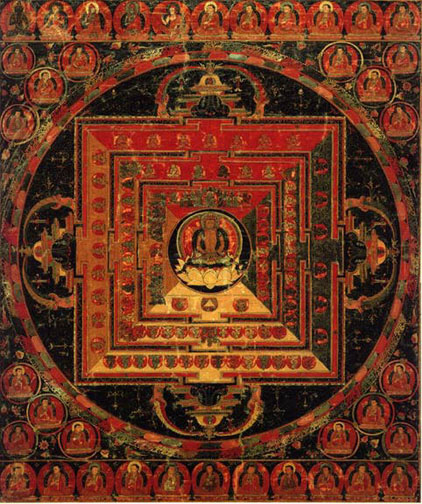| Abhisambodhi Vairocana Mandala
rnam-par sngan-byang-gi dkyil-'khor Central Tibet, 14th century 64 x 53 cm |
|
An inscription on the reverse identifies this painting as the mandala of Abhisambodhi Vairocana ("Mandala of the Awakening of Vairocana"), related to a Sanskrit text entitled, Mahavairocana-bhisambodhi Tantra (rnam-par snang-mdzad mngon-par byang-chub-pa'
i rgyud, "Tantra of the Awakening of Great Vairocana").1 Vairocana appears at the center of the mandala in his two-armed, one-faced form, a rich golden color. His highly complex assembly includes three palace chambers filled with hundreds of attendants.2
The teachings associated with this form of Vairocana were transmitted by a lineage of Buddhist masters represented in the top and bottom registers and enclosed by scrolling vines just outside the mandala proper. Each figure is identified by inscription o n the reverse. The lineage begins with the celestial bodhisattva Vajrapani and includes prominent Indian and Tibetan masters, including Buddhaguhya (sangs-rgyas gsang-ba), who wrote a commentary on the Mahavairocanabhisambodhi Tantra, translated during t he early introduction of Buddhism to Tibet (7th to mid-9th centuries).3 Among the last historical figures identified in the lineage is Lama Sangyebum (bla-ma sangs-rgyas-'bum), who, in 1214, became abbot of Tshal Gungthan (mtshal gung-thang) monastery in south-central Tibet.4 1 On this tantra, see Dudjom Rinpoche, The Nyingma School of Tibetan Buddhism, vol. 1, pp. 271-72. 2 A similar, though not identical, Abhisambodhi Vairocana mandala appears in Sonam Gyatso, Tibetan Mandalas, The Ngor Collection, pl. 20. 3 Samten Karmay dates Buddhaguhya to ca. active mid-ninth century. See Samten Karmay, The Great Perfection, p. 240. For a brief biography of Buddhaguhya, see Dudjom Rinpoche, The Nyingma School of Tibetan Buddhism, vol. 1, pp. 465-66. See also Roerich, The Blue Annals, pp. 351-52. 4 Roerich, The Blue Annals, p. 716.
|
